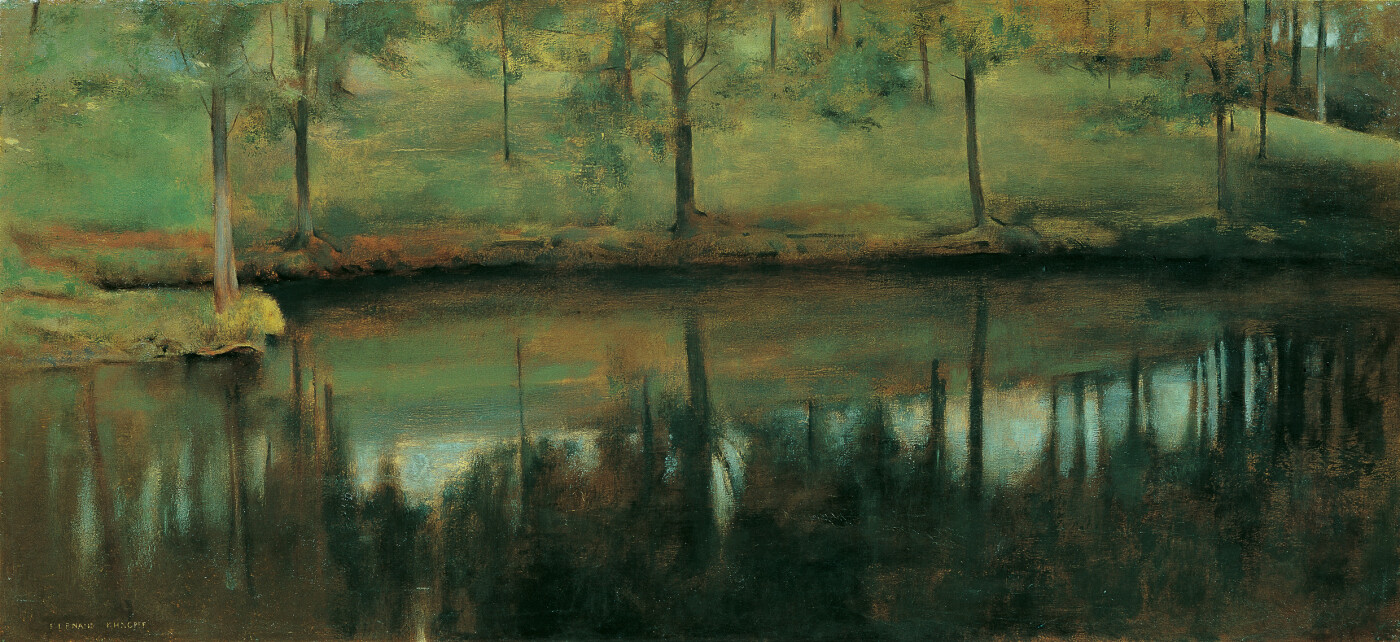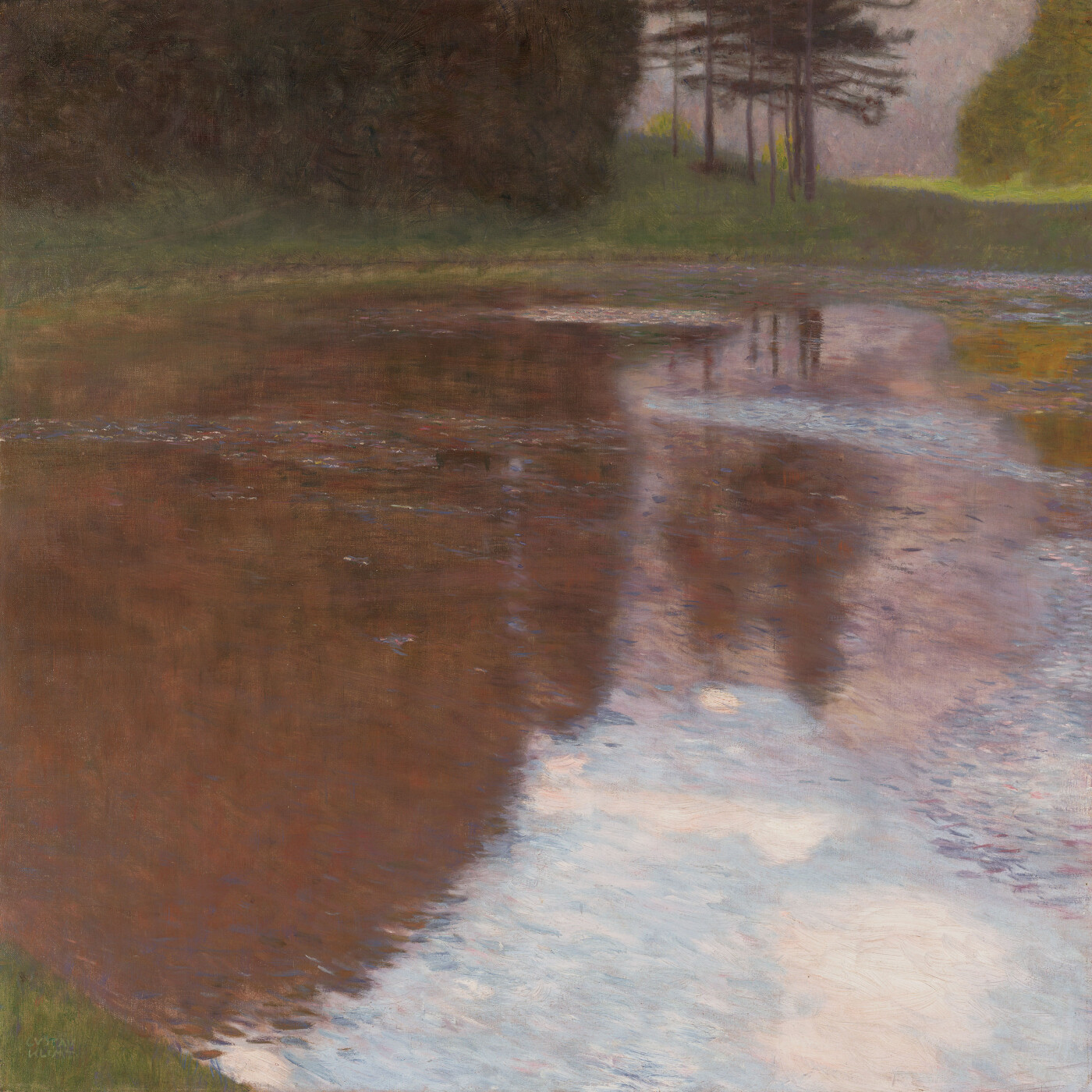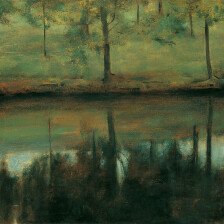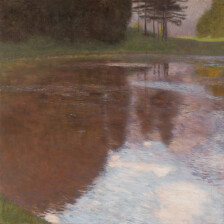Fernand Khnopff
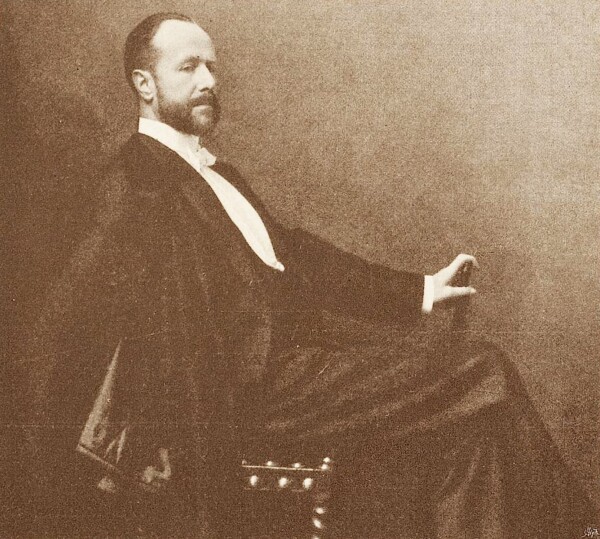
Fernand Khnopff, in: Die Graphischen Künste, 23. Jg. (1900).
© Heidelberg University Library
The Belgian painter, graphic artist, and photographer Fernand Khnopff was one of the leading exponents of Symbolism. While sojourning and exhibiting in Vienna, he impressed Gustav Klimt and the other artists of the Vienna Secession so much that a separate issue of the magazine Ver Sacrum was dedicated to him.
Fernand Khnopff was born on 12 September 1858 into a Belgian upper middle class family. In 1866 the whole family moved to Brussels, where Khnopff, starting in 1876, studied at the Académie royale des Beaux-Arts under Jan Portaels and Xavier Mellery. Initially, he mainly painted naturalistic landscapes and portraits, following his teachers’ example. Together with his brother, the poet Georges Khnopff, he regularly frequented the literary circles.
During several trips to Paris in the late 1870s, he studied the paintings of Old Masters and also came into contact with the English Pre-Raphaelites at the 1889 Paris World’s Fair. Their style would have a decisive influence on his work. Yet through his keen interest in contemporary literature he developed the Pre-Raphaelites’ language of form into a pictorial language that was meant to convey psychological and mystical content. This made him one of the first Symbolists in Belgium.
The work of Khnopff, who had already established himself as a successful portraitist in Brussels, was henceforth dominated by two types of women: The Femme Sphinx as a mystical and dangerous hybrid creature and her counterpart, the Femme Ange, as a heavenly, dreamy apparition.
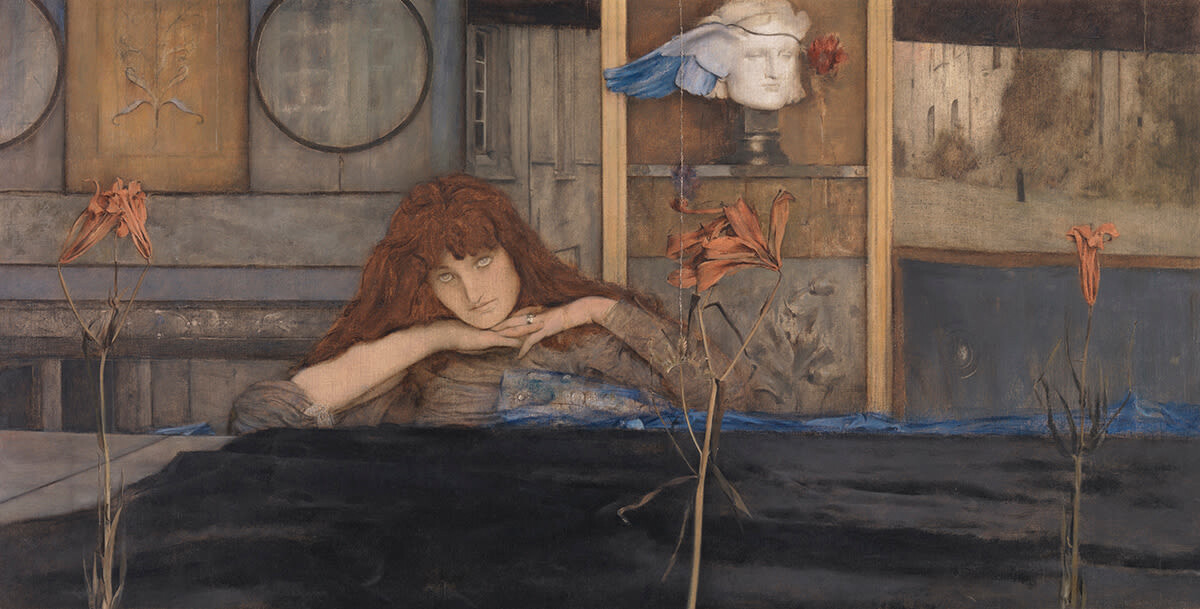
Fernand Khnopff: I lock my door upon myself, 1891, Neue Pinakothek Munich
© Bavarian State Painting Collections - Neue Pinakothek, Munich
In 1883, Khnopff was a co-founder of Symbolists’ group Société des Vingt, whose aim was to promote modern art and bring it closer to the public. However, group disbanded as early as 1893.
Throughout his life, Khnopff took part in diverse international exhibitions, which helped him achieve success across Europe. He also produced illustrations for several international magazines, such as The Studio, and for the works of well-known Symbolist writers like Stéphane Mallarmé.
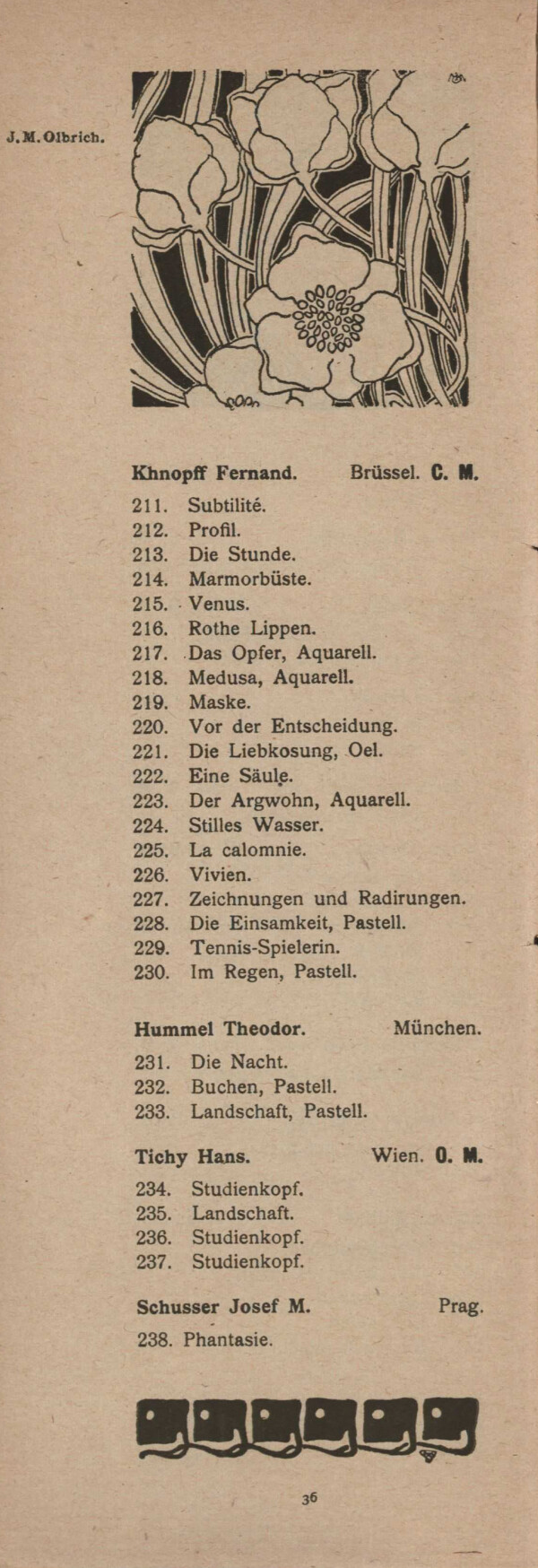
Fernand Khnopff at the I Secession Exhibition, in: Vereinigung bildender Künstler Österreichs Secession (Hg.): Katalog der I. Kunstausstellung der Vereinigung bildender Künstler Österreichs, Ausst.-Kat., Flower rooms of the k. k. Gartenbaugesellschaft (Vienna), 26.03.1898–20.06.1898, Vienna 1898.
© Library of the Belvedere, Vienna
Fernand Khnopff in Vienna
Khnopff exhibited in Vienna for the first time in 1895 as part of the “XXIII. Jahresausstellung der Genossenschaft der bildenden Künstler Wiens” [“23rd Annual Exhibition of the Cooperative of Visual Artists in Vienna”], where his work Memories (1889, Musées royaux des Beaux-Arts, Brussels) was awarded a gold medal. His works had become known in Austria even earlier, as they had been published in various magazines.
Shortly after the foundation of the Association of Austrian Artists Secession in 1898, the modern Belgian artist was appointed corresponding member of the young art movement. In spring that same year, he traveled to Vienna to take part in the association’s first exhibition, where he presented twenty works (sixteen paintings and four sculptures). According to an article by art critic Ludwig Hevesi, the artist – whom he characteristically referred to as the “chief mystic” – was very well received by both the Viennese public and the artists of the Vienna Secession: “Fernand Khnopff was recently in Vienna. The young people gave him the red carpet reception and celebrated him with a hearty feast.”
The young Secessionists’ and Viennese society’s admiration for Khnopff led to an entire issue of the magazine Ver Sacrum to be dedicated to him. Fernand Khnopff himself was responsible for the graphic design of issue No. 12 of the first year volume in 1898. After his successful participation in the Vienna Secession’s first exhibition, Khnopff also took part in the association’s second show, exhibiting seven works, including one of his masterpieces, L’Encens [Incense] (around 1898, Musée d’Orsay, Paris). Until 1911, the Belgian artist appeared in numerous other exhibitions organized by the Vienna Secession.
Gustav Klimt and Fernand Khnopff
Khnopff was certainly an important role model for the young Secessionists and their work. The influence of the Belgian painter is particularly noticeable in the works of Gustav Klimt dating from around 1900. If one compares Khnopff’s works exhibited at the Secession in 1898 with Klimt’s oeuvre, it becomes clear how much the Symbolist’s paintings served as a source of inspiration for Klimt.
Khnopff's Acrasia (The Faerie Queen) (1892, Musées royeaux des Beaux-Arts, Brussels) shows a red-haired, upright standing woman in the nude with a flowing blue cloth draped around her body. The entire depiction seems to flicker, lending the painting a mystical quality. The following year, Klimt presented his Nuda Veritas (1899, Theatermuseum, Vienna), for her part a red-haired, upright standing, naked female figure. The blue cloth in Khnopff’s Acrasia finds its counterpart in a moving sphere of water in the background. In his early allegorical paintings, Klimt generally used the same type of woman as Khnopff (red-haired, blue-eyed, with pale skin, corresponding to the ideal English type) and also adopted the latter’s flickering, almost grainy manner of painting. The aim here was to put the viewer into a kind of mystical trance.
Such similarities can also be observed in the landscape paintings. Both artists mainly created their landscapes during their summer retreats, with the Belgian inspired by the surroundings of Fosset and Klimt by the Attersee region. Khnopff presented Eau calme [Still Water] (c. 1894, private collection) in Vienna in 1898, to which Klimt responded with A Morning by the Pond (1899, Leopold Museum, Vienna). Khnopff’s À Fosset. Sous les sapins [In Fosset. Under the Fir Trees] (1894, Musées royeaux des Beaux-Arts, Brussels) probably served as an inspiration for Klimt’s Pine Forest I (1901, Kunsthaus Zug, Stiftung Sammlung Kamm) and Pine Forest II (1901, private collection).
Klimt and Khnopff
In 1904, Khnopff was commissioned to design panels for the music room at the Stoclet Palace in his hometown of Brussels. Here the two artists met again, as Gustav Klimt worked on the decoration of the dining room for the same building, for which he created the Stoclet Frieze (1905–1911, private collection) between 1909 and 1911.
In 1913, Khnopff was appointed member of the Académie royale de Belgique. Khnopff designed costumes and props for the Théâtre royal de la Monnaie in Brussels over a period of almost ten years. Fernand Khnopff died in Brussels on 2 November 1921 at the age of 63.
Literature and sources
- Ludwig Hevesi: Acht Jahre Sezession (März 1897–Juni 1905). Kritik – Polemik – Chronik, Vienna 1906, S. 15, S. 30-35.
- Agnes Husslein-Arco, Alfred Weidinger (Hg.): Dekadenz. Position des österreichischen Symbolismus, Ausst.-Kat., Lower Belvedere (Vienna), 20.06.2013–13.10.2013, Vienna 2013, S. 68-76.
- Genossenschaft der bildenden Künstler Wiens (Hg.): Katalog der XXIII. Jahresausstellung der Genossenschaft der bildenden Künstler Wiens, Ausst.-Kat., Artists' House (Vienna), 30.03.1895–09.06.1895, Vienna 1895.
- Vereinigung bildender Künstler Österreichs Secession (Hg.): Ver Sacrum. Organ der Vereinigung bildender Künstler Österreichs, 1. Jg., Heft 12 (1898).
- Vereinigung bildender Künstler Österreichs Secession (Hg.): Ver Sacrum. Organ der Vereinigung bildender Künstler Österreichs, 1. Jg., Heft 2 (1898), S. 28.
- Vereinigung bildender Künstler Österreichs Secession (Hg.): Katalog der I. Kunstausstellung der Vereinigung bildender Künstler Österreichs, Ausst.-Kat., Flower rooms of the k. k. Gartenbaugesellschaft (Vienna), 26.03.1898–20.06.1898, Vienna 1898.
- Vereinigung bildender Künstler Österreichs Secession (Hg.): Katalog der II. Kunst-Ausstellung der Vereinigung bildender Künstler Österreichs, Ausst.-Kat., Secession (Vienna), 12.11.1898–28.12.1898, Vienna 1898.
- Günter Meissner, Andreas Beyer, Bénédicte Savoy, Wolf Tegethoff: Allgemeines Künstler-Lexikon. Die bildenden Künstler aller Zeiten und Völker, Band LXXX, New York - Berlin 2014, S. 185.
- Hans Vollmer (Hg.): Allgemeines Lexikon der Bildenden Künstler von der Antike bis zur Gegenwart. Begründet von Ulrich Thieme und Felix Becker, Band XX, Leipzig 1927, S. 246.


